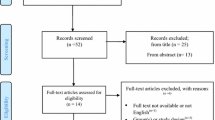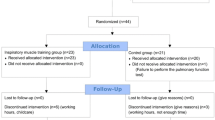Abstract
Pulmonary function is altered in ankylosing spondylitis (AS) owing mainly to the restriction of chest wall involvement (limited chest expansion). The objective of this study was to investigate the relationship between chest expansion, respiratory muscle strength (MIP, MEP) maximum voluntary ventilation (MVV), and BASFI score in patients with AS. Twenty-three male patients with definite AS and 21 age-matched healthy male controls were recruited for the study. Patients with AS were assessed for functional status by BASFI. Measurement of chest expansion and lumbar spinal flexion (modified Schober) method was performed in all subjects. Pulmonary function tests were performed by spirometry. Respiratory muscle strength was evaluated by a mouth-pressure meter (MPM). Body mass index (kg/m2) was recorded in all individuals. Chest expansion and modified Schober measurement were significantly lower in AS patients (p<0.05). Pulmonary function tests revealed restrictive lung disease. The mean BASFI score suggested good functional capacity in the AS group. The respiratory muscle strength and MVV were also lower in AS (p<0.05). The chest expansion was correlated with MIP and MEP values (r=0.491; p=0.02, r=0.436; p=0.05). Chest expansion was also correlated negatively with disease duration (r=−0.502; p=0.03). In addition, there was no correlation between chest expansion and BASFI score (r=−0.076; p=0.773). This study demonstrates that functional status (BASFI) is not influenced by the limitation of chest wall movement. It may be as a result of the maintenance of moderate physical activity during active life in patients with AS.
Similar content being viewed by others
Abbreviations
- AS:
-
Ankylosing spondylitis
- FEF:
-
Forced expiratory flow rate
- FEV1 :
-
Forced expiratory volume during the first second
- FVC:
-
Forced vital capacity
- MPM:
-
Mouth-pressure meter
- MVV:
-
Maximum voluntary ventilation
- VC:
-
Vital capacity
References
Feltelius N, Hedenstrom H, Hillerdal G (1986) Pulmonary involvement in ankylosing spondylitis. Ann Rheum Dis 45:736–740
Fisher LR, Crawley MID, Holgate ST (1990) Relation between chest expansion, pulmonary function, and exercise tolerance in patients with ankylosing spondylitis. Ann Rheum Dis 49:921–925
Grimby G, Fulg-Meyer AR, Blomstrand A (1974) Partitioning of the contributions of rib cage and abdomen to ventilation in ankylosing spondylitis. Thorax 29:179–184
Elliot CG, Hill TR, Adams TE (1985) Exercise performance of subjects with ankylosing spondylitis and limited chest expansion. Bull Eur Physiopathol Respir 21:363–368
Seçkin Ü, Bölükbasi N, Gürsel G (2000) Relationship between pulmonary function and exercise tolerance in patients with ankylosing spondylitis. Clin Exp Rheumatol 18:503–506
Arnett FC (1997) Ankylosing spondylitis. In: McCarty DJ, Koopman WJ (eds) Arthritis and allied conditions. A textbook of rheumatology, 13th edn. Williams & Wilkins, Baltimore, 1197–1208
Calin A, Garrett S, Whitelock HI (1994) A new approach to defining functional ability in ankylosing spondylitis: The development of the Bath Ankylosing Spondylitis Functional Index. J Rheumatol 21:2281–2285
Pıle KD, Laurent MR, Salmond CE (1991) Clinical asessment of ankylosing spondylitis. Br J Rheumatol 30:29–34
Moll JMH, Wright V (1971) Normal range of spinal mobility. Ann Rheum Dis 30:381–386
Quanjer PH, Tammaling GJ, Cotes JE (1993) Lung volumes and forced respiratory flows: Report of the Working Party on Standardization of Lung Function Tests; European Community for Steel and Coal official statement of the European Respiratory Society. Eur Respir J 6(suppl 16):5–40
Ries AL (1989) Measurement of lung volumes. Clin Chest Med 10:177–186
Gardner RM, Crapo RO, Nelson SB (1989) Spirometry and flow–volume curves. Clin Chest Med 10:145–154
Black LF, Hyatt RE (1969) Maximal respiratory pressures: Normal values and relationship to age and sex. Am Rev Respir Dis 99:696–702
Jentoft EE, Kvalvik GA, Mengshoel AM (2001) Effects of pool based and land based aerobic exercise on women with fibromyalgia. Arthritis Care Res 45:42–47
Van Noord JA, Cauberghs M, Van de Woestijne KP (1991) Total respiratory resistance and reactance in ankylosing spondylitis and kyphoscoliosis. Eur Respir J 14:945–951
Hagberg M, Hagmer IM, Bjella A (1987) Shoulder muscle strength, endurance, and electromyografic fatigue in ankylosing spondylitis. Scand J Rheumatology 16:161–165
Grassino A, Gross D, Macklem PT (1979) Inspiratory muscle fatigue as a factor limiting exercise. Bull Eur Pysiopathol Resp 15:105–111
Iandelli I, Gorini M, Misuri G (2001) Assessing inspiratory muscle strength in patients with neurologic and neuromuscular diseases. Chest 119:1108–1113
Vanderschueren D, Decramer M, Van Der Derede P, Dequeker J (1989) Pulmonary muscle function and maximal transrespiratory pressures in ankylosing spondylitis. Ann Rheum Dis 48:632–635
Carter R, Rıantawan P, Banhom SW (1999) An investigation of factors limiting aerobic capacity in patients with ankylosing spondylitis. Respir Med93:700–708
Enright PL, Kronneel RA, Monolo TA (1994) Respiratory muscle strength in the elderly. Am J Respir Crit Care Med 149:430–438
Gosselink R, Roosters T, Decromer M (1996) Peripheral muscle weakness contributes to exercise limitation in COPD. Am J Respir Crit Care Med 153:976–980
Palange P, Forte S, Onorati P (1998) Effect of reduced body weigth on muscle aerobic capacity in patients with COPD. Chest 114:12–18
Hopkins BGO, McDougall J, Mills KR (1983) Muscle changes in ankylosing spondylitis. Br J Rheumatol 22:151–157
Faus RS, Pardo MS, Rubio BJ (1991) Muscle pathology in ankylosing spondylitis. J Rheumatol 181:1368–1371
Author information
Authors and Affiliations
Corresponding author
Rights and permissions
About this article
Cite this article
Şahin, G., Çalikoğlu, M., Özge, C. et al. Respiratory muscle strength but not BASFI score relates to diminished chest expansion in ankylosing spondylitis. Clin Rheumatol 23, 199–202 (2004). https://doi.org/10.1007/s10067-003-0850-y
Received:
Accepted:
Published:
Issue Date:
DOI: https://doi.org/10.1007/s10067-003-0850-y




